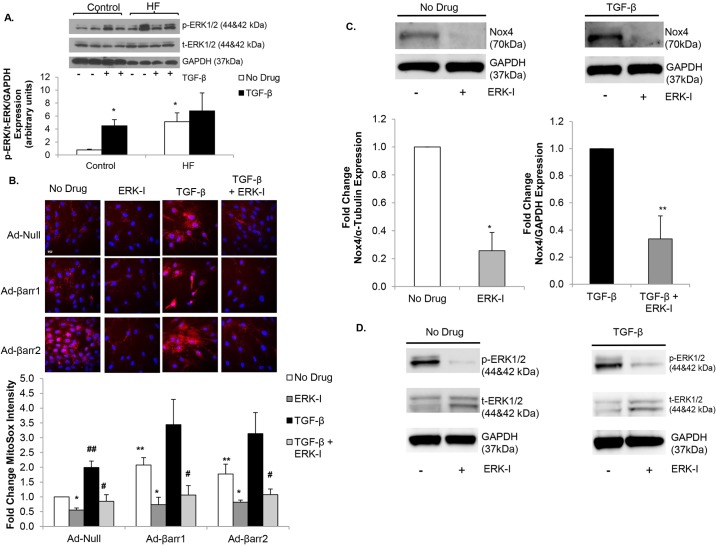Fig. 6.
β-arrestin-stimulated oxidative stress is mediated by ERK signaling. (A) Representative immunoblot (upper panel) showing phosphorylated ERK1/2 (p-ERK1/2) and total ERK1/2 (t-ERK1/2) expression under basal conditions versus TGF-β stimulation in control and heart failure (HF) cardiac fibroblasts (CFs). GAPDH was used as a loading control. Densitometric analysis is shown below. *P<0.05 vs Control+No Drug; n=3-6 in all groups. (B) Confocal images (upper panel) of control CFs stained with MitoSOX (red) following transfection with adenoviruses overexpressing β-arrestin-1 (Ad-βarr1), β-arrestin-2 (Ad-βarr2) or control null virus (Ad-Null) under basal conditions, treatment with ERK inhibitor PD98059 (ERK-I), TGF-β-stimulation, and pre-treatment with PD98059 prior to stimulation with TGF-β (TGF-β+ERK-I). Nuclei are stained blue with Hoechst 33342. Fluorescence quantitation is shown below. *P<0.05 vs No Drug; **P<0.04 vs Ad-Null+No Drug, #P<0.001 vs TGF-β, ##P=0.05 vs Ad-Null+No Drug; n=4 for all groups. Scale bar: 20 μm. (C) Representative immunoblots (upper panels) showing the effect of ERK inhibitor on basal (left panel) and TGF-β-stimulated (right panel) Nox4 expression in failing CFs. GAPDH was used as a loading control. Densitometric analysis is shown below. *P=0.01 vs No Drug, **P<0.03 vs TGF-β; n=3 in each group. (D) Representative immunoblots showing decreased basal (No Drug) (left panel) and TGF-β-stimulated (right panel) ERK1/2 phosphorylation following treatment with the ERK inhibitor (ERK-I) PD98059. GAPDH was used as a loading control.

